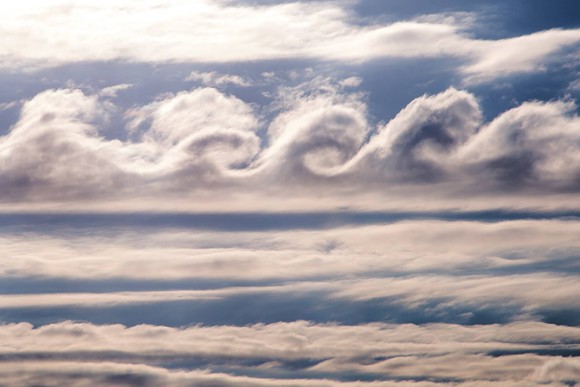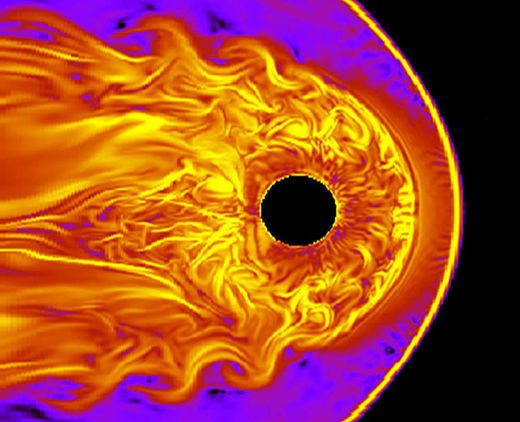
© www.democraticunderground.comIs it a wave or a cloud?
"Surfer's waves" are known for their
iconic series of curved hills all moving in the same direction and this pattern isn't just confined to coastal beaches. Scientists have seen this pattern all over the known universe -
on a scale as small as the cellular level and as large as the galactic level.According to two newly published studies - surfer's waves, also called
Kelvin-Helmholtz waves, can also be found in near-Earth space, a region of space that affects how solar radiation reaches our civilization.

© io9.comNASA photography of KH clouds.
Scientists have known that Kelvin-Helmholtz waves are
caused by a fast fluid, such as wind, moving over a slower fluid, like the ocean. This pattern can also be seen in cloud formations and on the surface of the sun.
"We have known before that Kelvin-Helmholtz waves
exist at the boundaries of Earth's magnetic environment - but they were considered relatively rare and thought to only appear under specialized conditions," study author Shiva Kavosi, a space scientist at the University of New Hampshire, said
in a press release. "It turns out they can appear under
any conditions and are much more prevalent than we thought. They're present 20 percent of the time."
Surfer waves appear in many situationsEarth is an enormous magnet, and its magnetic field stretches outward in a large bubble known as a magnetosphere. A continuous flow of particles from the sun, known as the solar wind, blows past the magnetosphere - similar to the way wind blows over the ocean. During particular situations, particles and energy from the sun can pass through the magnetosphere, and enter near-Earth space. This phenomenon causes space weather events that can affect our communications technology and power grids.
To determine the regularity of the Kelvin-Helmholtz waves around Earth,
the first study began by establishing the appearance of Kelvin-Helmholtz waves in numerical simulations. Then they used the Time History of Events and Macroscale Interactions during Substorms (THEMIS) Earth orbiter to discover when and where they occur. The team then linked that data with assessments of the solar wind.
While previous theories indicated that the Kelvin-Helmholtz waves would only occur under very particular situations, the team discovered that the waves showed up under a wide range of conditions.In the
second paper, published in the
Journal of Geophysical Research, researchers found Kelvin-Helmholtz waves
forming along the side of the magnetosphere's boundary. Prior to the waves starting, researchers saw
a reservoir of charged gas around Earth delivering a thin plume of plasma that traveled over 20,000 miles to make contact with the edges of the magnetosphere. This plume deposited even more atoms into the crucial sun-Earth boundary.This second study represents the first time these plumes were correlated with Kelvin-Helmholtz waves. The researchers noted that this find helps paint a more comprehensive picture of our magnetosphere.


Comment: We find these wave clouds on Jupiter and Saturn which means they are common phenomena throughout our solar system. Kelvin Helmholtz clouds are named for Lord Kelvin and Hermann von Helmholtz, who studied the physics of the instability that leads to this type of cloud formation. It's widely believed that these waves in the sky inspired the swirls in van Gogh's masterpiece Starry Night.